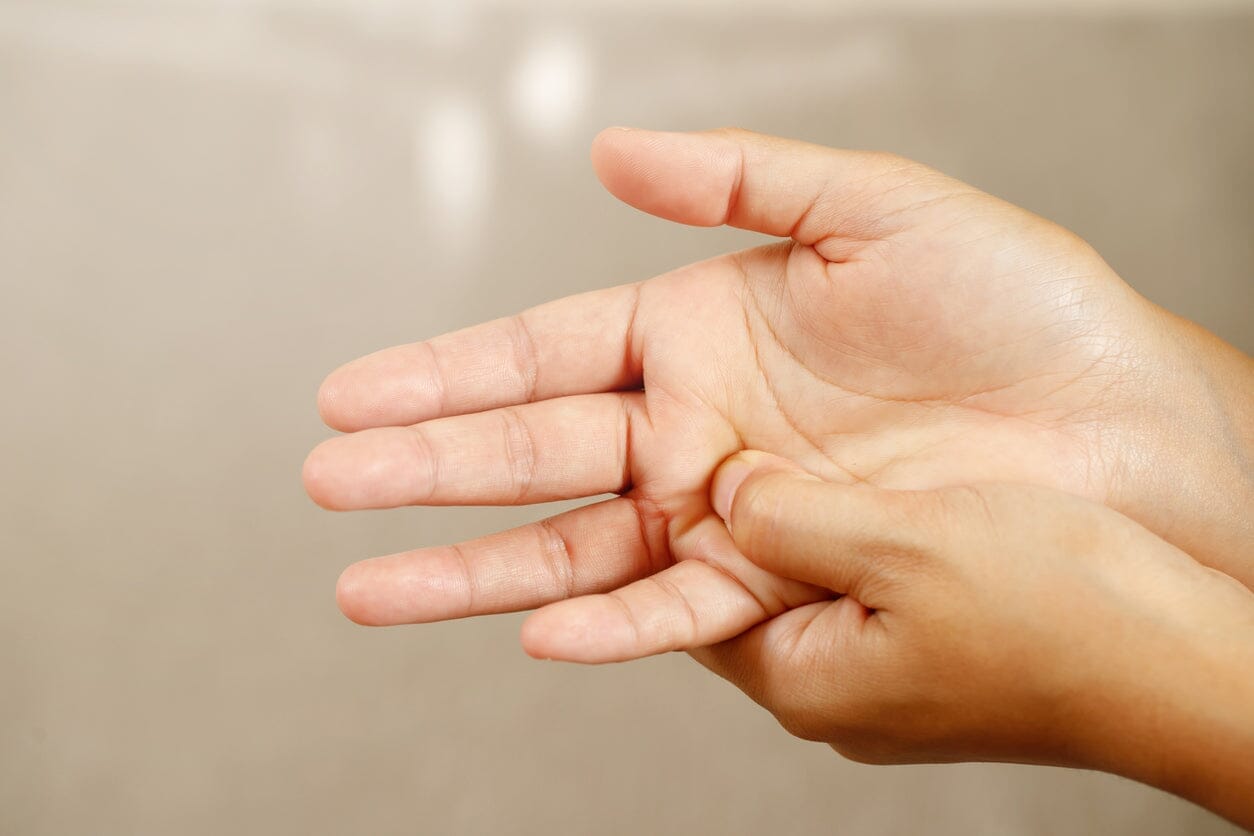
Is menopause causing your tingling extremities, and what can you do?
If you’re experiencing tingling, numbness or a feeling of ‘pins and needles’ in your hands, feet, limbs, face or body, it could be one of the less common symptoms of menopause. It’s called paraesthesia and for many women it seems to coincide with fluctuations in reproductive hormones like oestrogen during perimenopause – the transition to menopause.
Although more research is needed, the link between perimenopause and paraesthesia may involve the roles these hormones play in nerve signalling and circulation around your body.
Menopausal paraesthesia can be disconcerting and distracting, but for some women it’s also painful – more of a burning sensation than a tingling. Below, we’ll look more closely at paraesthesia symptoms and possible causes, as well as treatments and lifestyle changes that might improve things.
If you also have other menopause symptoms, The Better Gut probiotic can help. This award-winning menopause supplement has been shown in scientific studies to reduce a whole range of symptoms, from hot flushes to digestive problems, anxiety to brain fog.
To find out more visit Better Gut, where you can use the discount code WELCOME10 to get 10% off your first order.
Do hormone changes during perimenopause and menopause cause paraesthesia?
It’s not completely clear what causes paraesthesia during perimenopause and menopause and there’s currently not much research looking directly at whether it’s linked to hormone changes.
However, fluctuating levels of oestrogen and progesterone do lead to a wide variety of other menopause symptoms, including hot flushes, brain fog and anxiety, and there are some reasons to think the same could be true of paraesthesia.
One clue is the fact that some pre-menopausal women experience paraesthesia in the days before their periods – another time when hormones are in a state of flux and oestrogen levels are low.
We also know that oestrogen plays a role in the functioning of the central nervous system, including how it communicates sensations around your body. It’s possible that changing levels of oestrogen during perimenopause could disrupt these signals, leading to unusual sensations. It may also partly explain why women can become more sensitive to pain during the menopause transition.
Another symptom of menopause can be poorer circulation, particularly to your extremities. Anyone whose arm has ‘gone to sleep’ after they’ve leant on it for too long, will know that cutting off the circulation like this can lead to exactly the kind of numbness, followed by pins and needles, that some women experience during perimenopause.
Still, more research is needed to confirm whether any of these factors do contribute to perimenopausal paraesthesia, and why some women experience it and others don’t.
What does menopausal paraesthesia feel like?
Although menopausal paraesthesia is most often described as a tingling feeling, you may experience any of a whole range of sensations in the affected areas.
Some of the different ways women describe their paraesthesia include:
- tingling
- buzzing
- pins and needles
- prickling
- crawling
- static
- numbness
- stinging
- burning
- nerve pain
- electric shock
You may also experience different sensations at different times, such as numbness followed by pins and needles.
Where in your body can you get menopausal paraesthesia?
Everyone’s experience of perimenopause and menopause is different and women report paraesthesia in a wide range of places around their bodies, including:
- hands and feet
- arms and legs
- face and head
- ears
- chest, torso or whole body
Symptoms may change over time, moving from one place to another. You may also feel them in very specific areas, such as a particular numb spot.
It’s important to be aware that paraesthesia can sometimes be a symptom of another health condition. See the section at the bottom of this article for more details and to find out when you should see a doctor.
Tingling and numb hands and feet
Tingling in your extremities, such as your hands and feet, is one of the most common forms of paraesthesia. It can often be felt as pins and needles and the areas can become numb.
While not dangerous in itself, numbness in your feet could mean you’re more at risk of losing your balance and falling, while numb fingers and hands can make it hard to grip and to do things like type or write.
Tingling face or head
Your face is another common location for paraesthesia. You may feel it on just the lower part of your face, including your lips. It can sometimes feel as if there’s something on your face that you want to brush off.
As well as a tingling sensation, paraesthesia around your head can be a pulsating feeling or involve sharp pains.
Tingling ears
If you’re experiencing tingling ears during perimenopause or after menopause, you’re not alone. Some women notice it specifically on their ear lobes, and even inside their ears.
While this tingling sensation on your skin is not the same as tinnitus – a ‘phantom’ ringing sound in your ears – some women do experience the two together during perimenopause.
Treatments and lifestyle changes that may help with paraesthesia
Eating a balanced diet, exercising regularly and stopping smoking are some of the best things you can do for your overall health, and they may help with paraesthesia too. Hormone replacement therapy (HRT) may also be an option if your symptoms are caused by the menopause transition.
A healthy diet
A healthy, balanced diet will help to keep your nervous system functioning properly and could also reduce the severity of some menopause symptoms.
To make sure you’re getting a wide range of nutrients, try to include as many different plants as possible – fruits and vegetables, beans and pulses, nuts and seeds. Choose wholegrains over highly processed options such as white rice and bread, and limit ultra-processed foods like packaged snacks and sugary drinks.
Many plants contain compounds called phytoestrogens. These mimic some of the functions of oestrogen and may reduce certain menopausal symptoms. Beans and pulses, especially soyabeans, are a particularly good source of phytoestrogens called isoflavones.
Regular exercise
Regular exercise improves your circulation, which could help with numbness and pins and needles. It’s also been shown to reduce pain sensitivity and other menopause symptoms.
The NHS and CDC recommend doing at least 150 minutes each week of moderate exercise, like brisk walking, or 75 minutes of intense exercise, such as running, spread over several days. You should also try to include a couple of sessions of strength work, such as weight training or bodyweight exercises.
If you don’t currently do much exercise, start slowly and work your way towards these targets.
Stopping smoking
Just as exercise improves your circulation, smoking does the opposite, narrowing your blood vessels and reducing blood flow. In fact, just a single cigarette is enough to shut down the tiny blood vessels in one of your toes for up to three hours. Smoking can also increase your sensitivity to pain.
While stopping smoking can be a challenge, the NHS and CDC offer plenty of help and support.
Hormone replacement therapy
HRT replaces the oestrogen and progesterone lost due to menopausal changes. Although it can help with lots of menopause symptoms, including hot flushes, mood swings and vaginal dryness, it doesn’t necessarily work for them all, or for everyone who tries it.
There’s not much research looking at the impact of HRT on paraesthesia but, anecdotally, many women say it has reduced or got rid of their symptoms, while others say it hasn’t helped.
If you’re thinking about trying HRT, talk to your doctor about whether it’s right for you and which treatment is the best option.
Other causes of paraesthesia and when to see a doctor
If you regularly have paraesthesia or numbness, and it’s not due to menopause, there are other medical conditions that could be causing it. These include:
- Diabetes: you may experience pins and needles or numbness in your hands and feet
- Raynaud’s: this circulatory disease can also cause your fingers or toes to change colour
- Sciatica: when your sciatic nerve is compressed, it can cause pain and pins and needles from your back, down your leg and into your foot
- Multiple sclerosis: numbness or tingling sensations can also be accompanied by muscle stiffness and spasms, fatigue and problems with balance, thinking and vision
- Shingles: this disease caused by the chickenpox virus leads to a painful rash on one side of your body that can begin with a tingling feeling
- Carpal tunnel syndrome: this problem with pressure on the nerve in your wrist can cause tingling, numbness and pain in your fingers
- Nerve damage or a trapped nerve
- Migraines
- Stroke or transient ischemic attack/’mini stroke’
- Thyroid problems
Don’t try to diagnose the problem yourself – if you have any of these issues, contact your doctor.
Pins and needles can also have other causes, including:
- drinking too much alcohol
- poor diet
- poisonous substances
- certain medications
- medical treatments, such as chemotherapy
- abnormal levels of calcium, potassium or sodium
- vitamin B deficiency
- insect or spider bites
- seafood toxins
If you regularly have paraesthesia or pins and needles, or it keeps coming back, you should talk to your doctor.
Summary
Paraesthesia is a tingling, crawling or burning sensation in your hands, feet, face, limbs or body. Although it’s not one of the most common symptoms, some women experience it during perimenopause, or after menopause.
Scientists don’t fully understand what causes menopausal paraesthesia but it may involve changing levels of hormones like oestrogen and their effects on your nervous system and circulation.
Paraesthesia can also be caused by a number of other medical conditions. If you have related symptoms or your paraesthesia keeps coming back, you should talk to a doctor.
If your doctor thinks your paraesthesia is caused by hormone changes during perimenopause or menopause, they might suggest hormone replacement therapy.
Lifestyle changes may also help. Try eating a healthier diet, including a wide range of plants, exercising regularly and, if you smoke, get support with quitting.
If you have other menopause symptoms, try the Better Gut probiotic supplement.
These award-winning menopause supplements contain beneficial bacteria that have been shown in scientific studies to help with:
- hot flashes and night sweats
- mood and symptoms of anxiety and depression
- brain fog and mental fatigue
- sleep quality
- bloating and constipation
- vaginal health
- maintaining a healthy weight
- bone density and osteoporosis risk
- inflammation and immune health
Discover Better Gut and use the discount code WELCOME10 to get 10% off your first order.
Discover our powerful formulations
-
Regular priceFrom £59.00Regular priceSale priceFrom £59.00 Save £-59.00 (%)Unit price/ per
Better Gut
in your cart -
Regular priceFrom £57.00Regular priceSale priceFrom £57.00 Save £-57.00 (%)Unit price/ per
Better Metabolism
in your cart






